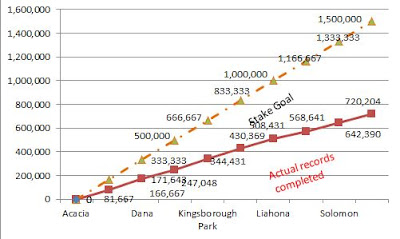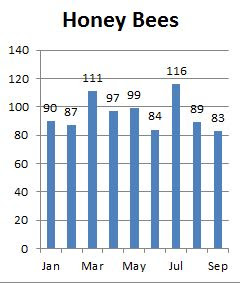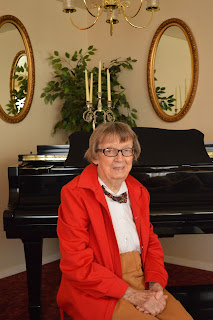Click on the following links:
This blog provides support for "Indexers" in the Mesa South Stake (training, links to useful sites), reports and other helpful hints for indexing
Sunday, October 2, 2016
Arbitrator Training
Definition of "Arbitrator" = Someone who works at MacDonald's that used to work at Arby's
Click on the following links:
Click on the following links:
September 2016 Indexing report
Thanks to all you HONEY BEES out there! Here is the September 2016 Honey Bee Buzz report.
Here are 2 good links on arbitration.
You used to be able to see your "arbitration results" when you opened indexing on your computer. That feature is no longer available. However, you should click on the tab "arbitration results" on occasion to see how you are doing.
When you do, it will open a page that gives a list of the recent batches you have been working on and a column to the right that says "Agreement % " for that particular batch. That is a calculation of how often your records agree with the Arbitrators records. It is a good idea to click on each batch to see what the differences are between what you entered and what the Arbitrator entered and learn from your mistakes.
Sometimes, you feel you are correct and the arbitrator is wrong. You have an opportunity to ask that the arbitration be reviewed again. Don't be timid about doing this if you know you are correct because feed-back is given to the Arbitrators and they learn as well.
There is another statistic given to the Stake Indexing directors that you should know about. It is a report of "Re-dos"
The following is a chart showing the amount of Re-dos in the Stake.
Each index batch is completed by 2 different people, Person A and Person B. When an arbitrator opens the batch, the arbitrator will see the batch prepared by Person A side by side with the batch prepared by Person B. If for example, the arbitrator observes that Person B has not completed the batch or is not indexing the batch correctly, the arbitrator will send the batch back to the system. If you are Person B, it means that your batch has to be re-done by someone else. Person B does not get credit for the batch and the stake report will show the total number of Re-Do batches for that person. The Stake and Ward Group Administrators can use this information to help someone who has a large number of "Re-Dos".
Unfortunately, you cannot see the number of "Re-Dos" yourself. If you want to know how many re-dos you have, ask your Ward Group Administrator or get in touch with us.
Here is a link that discusses Re-do batches further:
In the chart above, the Stake has 57 Re-Do "batches" for the month of September which amounts to 0.7% of the total "Records" completed by the Stake. Records and Batches are not the same thing, but maybe it somewhat shows the rate of re-dos.
However, the Stake goal is that there be 'NO' Re-do batches.
How to become and Arbitrator
Basic Arbitrator Instructions
Every Indexer in the Stake should read the following:
Examples of Arbitration Errors
Basic Arbitrator Instructions
Every Indexer in the Stake should read the following:
Examples of Arbitration Errors
Monday, September 12, 2016
August 2016 Honey Bee Buzz report
The following video is a reminder to all of us as to why we do indexing.
Natalia Lopes
We are pleased to highlight Natalia Lopes from the Kingsborough Park Ward and recognize the wonderful service she is performing as an Indexer and Arbitrator. We hope you are inspired by her comments.
Sunday, August 7, 2016
Bees all over the World!
The Mesa South Stake had great participation in the World Wide Indexing Event. Evidently we are not the only Honey Bees in the World!
"If you spent part of your weekend participating in the worldwide indexing event, you were in good company. The event far surpassed its goal of 72,000 participants around the globe; a total of 116,475 individuals worked to make the world’s historical records available to those doing their family history work. These individuals indexed 10,447,887 records to add to the treasure trove of information available to family history researchers." Family Search Indexing Blog
"If you spent part of your weekend participating in the worldwide indexing event, you were in good company. The event far surpassed its goal of 72,000 participants around the globe; a total of 116,475 individuals worked to make the world’s historical records available to those doing their family history work. These individuals indexed 10,447,887 records to add to the treasure trove of information available to family history researchers." Family Search Indexing Blog
Read about the event here: WORLD WIDE INDEXING EVENT
Why do we do indexing? Here is a short video you will enjoy.
Thank you to all the Honey Bees in the Mesa South Stake. Here is the report for July.
Keep up the great work!
Sunday, July 3, 2016
What is the difference between a 'June Bug' and a Honey Bee?
What is the difference between a June Bug and a Honey Bee?
Read this indexing report and find out!
Indexing in the Mesa South Stake
Solomon Ward completed the most records during the month of June. Good Job!
We are significantly lower on the total number of records completed as to where we should be to accomplish the goal of 2 million records in the year.
We had a total of 84 active Honey Bees during the month of June
**************************************
Join the team of indexers for a world wide indexing event July 15 to July 17.
The goal for this year’s event is to have at least 72,000 volunteers index as many records as possible in a 72-hour period, July 15 to 17
Visit the following web site to sign up as your commitment to be part of the Team during this special event.
XXXXXXXXXXXXXXXXXXXXX
So what is the difference between a 'June Bug' and a Honey Bee?
The June Bug belongs to the Phyliophaga genus of Beetles
Can you see the difference between the June Bug above and the Honey Bee below?
One stings and the other one doesn't.
What does this have to do with Indexing in the Mesa South Stake?
(not much)
We are not June bugs who only index a few months out of the year and then go into hibernation.
We are Honey Bees! We gather nectar every month!
A big thank you to all those who indexed this month.
Saturday, June 4, 2016
The Buzz Report---May 2016--Are you ready to SWARM !!!
We had a great month for indexing in the Mesa South Stake. There were 99 active Honey Bees gathering nectar as well as some new indexer.
The Honey Bee Highlight of the month is Ruth Haws from the Lazona Ward:
Here is a report for May:
The Honey Bee Highlight of the month is Ruth Haws from the Lazona Ward:
=> CLICK HERE
Here is a report for May:
Please encourage everyone to index. Our most important goal is to have 200 active Honey Bees every month!
Leave a comment on the blog if you like!!!
xxxxxxxxxxxxxxxxxxxxxxxxxxxxxxxxxxxxxxxxxx
Look out! We are getting ready to swarm! Announcing a worldwide event. Between July 15 and 17 we are going to have over 72,000 people complete at least one batch of indexing!
Get your family involved. Organize a Young Women or Young Men group. Let's swarm the hive!!
Ruth Haws of the Lazona Ward
Our highlight for the month is Ruth Haws from the Lazona Ward.
Ruth indexes every day of the year, rain or shine. She has a wonderful testimony of indexing---how it blesses the lives of others as it blesses her own life because of the feeling she gets knowing she is contributing in a positive way to a great work.
Listen to her testimony here. CLICK HERE
Ruth has a 93% accuracy ratio and indexes Spanish records on a regular basis.
She has been indexing since the 1970's! Things have really changed since then.
Sunday, May 1, 2016
April 2016 Indexing Report: How many honey bees in a hive?
I tried to count the bees in my hive, but I only got to
3. They all kept moving and look alike.
What does it take to become a Mesa South Stake Honey Bee?
Ans: Index at least
one batch per month. Every little bit of
nectar helps!
Which ward indexed the most records in the month?
The wonderful work accomplished by the Mesa South Stake Honey Bees is greatly appreciated!
Please check on the post "CLOSING THE GAP" click here
Closing the Gap--Introduction to Foreign Language Indexing
An impressive number of Records have been indexed. See chart below.

The LDS
Church has 14,782,478 members worldwide, with 56 percent living outside the
United States and Canada. But far more records are available for members from English speaking countries than non-English speaking countries.
HELP CLOSE THE GAP!
You can help close the gap:
if you speak a foreign language
served a mission in a foreign language
or even if you don't have any foreign language, but are willing to learn some very simple words. For example if you were doing Spanish records---do you think you can learn?
UNO = ONE
DOS = TWO
Cemetario = cemetary
Defunccion = Death
Listen to Inspector General to see just how easy indexing in Spanish can be!
You will need some help to get started. We hope to provide training on a ward by ward basis some time in the future. But if you follow the steps out lined below, you can get started right away.
Step 1: Find a Spanish record to index. Look for a beginning record. For example:
Step 2: Read the project instructions: VERY IMPORTANT ! !
Step 3: Click "Help"; "Resource Guide"; "Indexer" to get Language and Handwriting Helps
You can also get to this point by clicking the link below.
Set your language preference and take the training.
Friday, April 1, 2016
March Indexing Report
This blog reports on all the great work accomplished by the
Mesa South Stake HONEY BEES in the month of March 2016.
The following shows the sum total of the “Records” + “Arbitrated”
by ward.
The following provides the total number of Honey Bees. We had a major increase in the number of
Honey Bees. Much of this increase is because of the hard
work put in by the Solomon Ward Group Administrator, John Ogden and the great
efforts put in by the Young Women of the Liahona 1 Ward.
Please click on these links for the information indicated :
You will not want to miss the Honey Bee Highlight of the
month, the Young Women of Liahona 1 Ward and their Group Administrator, Berta Lujan.
Preferred Projects:
We invite those who would like to participate in a “Preferred Project”
to click here for an explanation of what it is.
New Indexer: If you
are new to indexing or just need help click below:
Liahona 1st Ward
We are pleased to highlight the Young Women of the Liahona 1st Ward and Sister Berta Lujan, the Ward Indexing Director.
We give our special thanks to Shannon Lista, Nadia Morello and Shelem Romero, the adult Young Women Leaders who made this happen and for the constant help and testimony of Berta Lujan.
The Liahona 1 Young Women are participating in Family History by working on indexing in spite of the difficulties many have because they do not have computers in their home.
We give our special thanks to Shannon Lista, Nadia Morello and Shelem Romero, the adult Young Women Leaders who made this happen and for the constant help and testimony of Berta Lujan.
The Liahona 1 Young Women are participating in Family History by working on indexing in spite of the difficulties many have because they do not have computers in their home.
Preferred Projects
The Church
of Jesus Christ of Latter-day Saints has missionaries assigned all over the
world to photograph vital statistic records that have value to family history
research. Some of these projects come as contracts between the Church and the Repository of the Records where there are
specific time limit requirements. The project is put on the "Preferred List" when the time limit is approaching and there is still a lot of work to be done.
The US Pennsylvania Marriage Records is one of those preferred projects. The Mesa South Stake is not "adopting" a single project and you may work on any project that suits your circumstances and/or interests, but if you want to help with a preferred project, we invite you to help on the US Pennsylvania Marriage Records.
The US Pennsylvania Marriage Records is one of those preferred projects. The Mesa South Stake is not "adopting" a single project and you may work on any project that suits your circumstances and/or interests, but if you want to help with a preferred project, we invite you to help on the US Pennsylvania Marriage Records.
The following is an example image of this project.
Not all of the images are handwritten. Some are type written. Follow these instructions to find the Preferred projects
Open and sign in to the indexing program as normal.Click on preferred projects and the US Pennsylvania—Marriage Records
Open and sign in to the indexing program as normal.Click on preferred projects and the US Pennsylvania—Marriage Records
It is very important to read the project instructions before you get started.
And always click on “Field Help” whenever you have specific
questions about a particular field.
Any time you need personal help, call the Stake Indexing Directors or your Ward Index Director (if your ward has one) and ask to "SHARE A BATCH".
Click on the following link to watch a short video on how to share a batch.
Subscribe to:
Posts (Atom)





















































